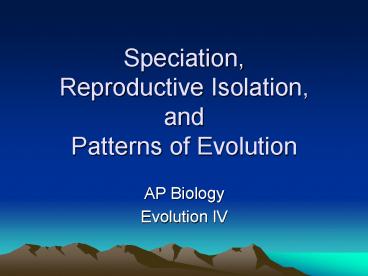Speciation, Reproductive Isolation, and Patterns of Evolution - PowerPoint PPT Presentation
1 / 17
Title:
Speciation, Reproductive Isolation, and Patterns of Evolution
Description:
Speciation, Reproductive Isolation, and Patterns of Evolution AP Biology Evolution IV Speciation Species: a group of individuals capable of interbreeding Speciation ... – PowerPoint PPT presentation
Number of Views:185
Avg rating:3.0/5.0
Title: Speciation, Reproductive Isolation, and Patterns of Evolution
1
Speciation, Reproductive Isolation, and
Patterns of Evolution
- AP Biology
- Evolution IV
2
Speciation
- Species a group of individuals capable of
interbreeding - Speciation the formation of new species (3 main
types) - Allopatric Speciation
- Sympatric Speciation
- Adaptive Radiation
3
Allopatric Speciation
http//www.nodvin.net/snhu/SCI219/demos/Chapter_4/
4
Allopatric Speciation
- Occurs when a population is divided by a
geographic barrier - Barriers mountains, rivers, regions excluding
vital resources (water, food) areas covered with
volcanic lava - Interbreeding between populations not possible
(reproductive isolation) - Gene frequencies can diverge due to natural
selection, mutation, and genetic drift
5
Sympatric Speciation
apple maggot flies apples hawthorns
6
Sympatric Speciation
- The formation of new species without the presence
of a geographic barrier - Occurs by one of 3 ways
- Balanced Polymorphism
- Polyploidy
- Hybridization
7
Balanced Polymorphism
- Suppose a population of insects possesses a
polymorphism for color. Each color provides a
camouflage to a different substrate (rock, tree
stump, etc..). - When not camouflaged, they are eaten
- Thus, only insects with the same color can
associate and mate - Similarly colored insects are reproductively
isolatedso gene pools can diverge.
8
Polyploidy
- More than 2 sets of chromosomes found in diploid
(2n) cells. - Often occurs in plants (occasionally animals)
where triploid (3n), tetraploid (4n) and higher
chromosome numbers exist. - Caused by nondisjunction in meiosis
- Tetraploid individuals will continue to produce
diploid gametes making them reproductively
isolated very quickly.
9
Hybridization
- Occurs when 2 different forms of a species mate
and produce offspring along a geographic boundary
called a hybrid zone. - The genetic variation of the hybrids is greater
than that of either parent - This permits hybrids to adapt to environmental
conditions beyond the range of either parent. - Hybrids can eventually diverge from parent forms
when faced with selective pressures
10
Adaptive Radiation
11
Adaptive Radiation
- Relatively rapid evolution of many species from a
single ancestor. - Ancestral species colonizes an area where diverse
geographic or ecological conditions are available
for colonization. - i.e. many available ecological niches for a
population to spread into. - Examples Darwins Finches, Australian Marsupials
12
Patterns of Evolution
- Evolution can take place along the lines of the
following patterns - Divergent Evolution
- Convergent Evolution
- Parallel Evolution
- Coevolution
13
Divergent Evolution
- Describes two or more species that originate from
a common ancestor. - This may happen as a result of allopatric or
sympatric speciation or by adaptive radiation
14
Convergent Evolution
- Describes two unrelated species that share
similar traits. - Similar traits arise because each species has
independently adapted to a similar niche - These traits are called Analogous Traits
15
Convergent Examples
- Sharks, porpoises, and penguins have
torpedo-shaped bodies with peripheral fins.
These traits arise as a result of adaptations
each species has made to aquatic lifenot due to
a common ancestor. - The eyes of squids and vertebrates are physically
and functionally similar. However they are not
from a recent common ancestor, both evolved
independently to perform similar functions.
16
Parallel Evolution
- Describes two related species or two related
lineages that have made similar evolutionary
changes after their divergence from a common
ancestor - Example
- Species from two groups of mammals, the marsupial
mammals and the placental mammals, have
independently evolved similar adaptations when
ancestors encountered comparable environments
17
Coevolution
- Describes the evolution of one species in
response to new adaptations that appear in
another species - An example evolutionary arms race between
predators and preyor - Plants and plant eating insects
- Pollinators and flowering plants
- Pathogens and animal immune systems































